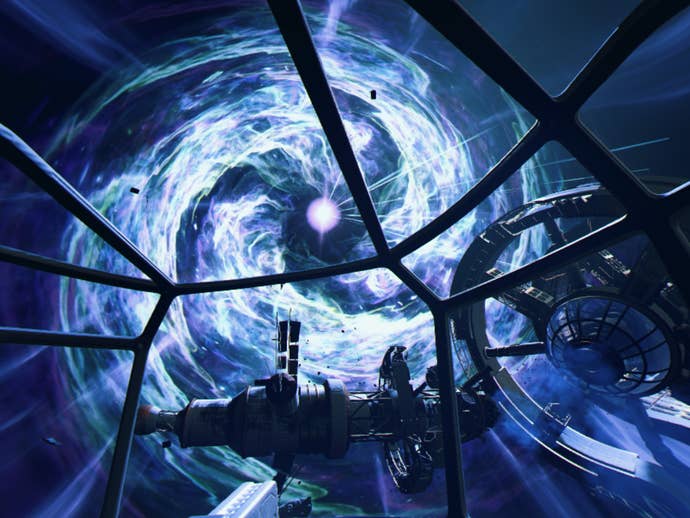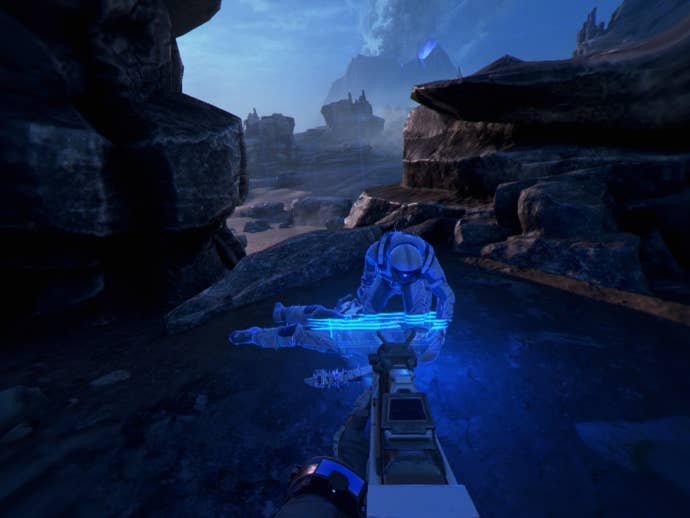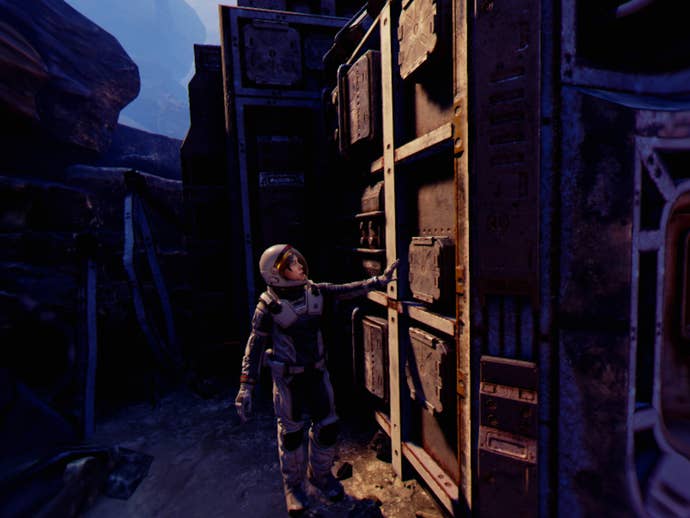Farpoint Review: A Great VR Experience, But Just An Okay Game
The next flagship PlayStation VR game shows off a new peripheral.
This article first appeared on USgamer, a partner publication of VG247. Some content, such as this article, has been migrated to VG247 for posterity after USgamer's closure - but it has not been edited or further vetted by the VG247 team.
When it comes to games, it felt like Sony had forgotten about the PlayStation VR for a few months there. There was the launch of Resident Evil 7, a game that stood as an amazing showcase of Sony's consumer-level virtual reality headset, alongside a number of smaller games like Until Dawn: Rush of Blood, Robinson: The Journey, and Rez Infinite. Then there was gulf that was only filled until recently with releases like Polybius and now, Farpoint.

Farpoint stands as the next step forward for the PlayStation VR. Every copy of Farpoint will set you back $79.99, because the game comes with the brand-new PlayStation VR Aim Controller. (You can buy it for $49.99 by itself, but don't.) So Farpoint is a PlayStation VR highlight and Sony's way of convincing you that you need the Aim Controller.
Farpoint places you in the spacesuit of the pilot of The Wanderer, a ship sent to touch base with the Pilgrim space station. The Pilgrim is studying a spatial anomaly that's providing limitless energy, but none of that matters to you, as you're just an galactic Uber there to pick up scientist Eva Tyson and Grant Moon. Things don't go as planned, the anomaly bursts open, and everything in the vicinity finds itself sucked into a wormhole.

The player character is largely silent except for a few lines expressing dismay and conversing with your AI computer counterpart. In fact, the story isn't really your story. Instead, you relive the adventures of the other two survivors, Tyson and Moon, as they attempt to find the Pilgrim and get back home. These folks are your emotional hook, acting like Matt Damon in The Martian, just two likable people in far over their head. As the story progresses the nature of this alien world begins to make itself known and things go from hard, to decent, and back to hard again.
Your job is to dutifully trace their path over the planet, shooting nearly everything that you come into contact with. Here, the PlayStation VR Aim Controller shows off its stuff. First of all, it's far more comfortable than trying to handle both PlayStation Move controllers. It feels right once you have it in your hands and all the major PlayStation system buttons are at hand. I'm glad Sony and developer Impulse Gear went with this instead of a remix of the PlayStation Move Sharp Shooter. That wasn't a horrible peripheral, but the Aim Controller beats it by being a single piece of hardware.

Once you're in-game and everything is calibrated, the Aim Controller allows for great precision. Firing without the holographic sight is pretty easy and the entire system is fairly on target; if you aim at something, you'll likely hit it. Since it's so accurate, the game lacks any real aim assist. Farpoint only really lets you do one thing - shoot - so it's good that shooting feels pretty great.
There's a limited inventory system in the game. You'll start the game with a basic Assault Rifle, which has infinite firing with an overheating system to prevent you from keeping the trigger pulled. (In VR, the holographic sight on the Assault Rifle is a fairly cool effect.) From there, your arsenal grows to include the Shotgun, Precision Rifle, Plasma Rifle, and Needle Gun. Some of those weapons are augmented by secondary fire modes, like the Assault Rifle's Guided Rockets or the Shotgun's Grenades. You carry two, offering a certain amount of strategy and choice. Do you stick with the Assault Rifle's endless firing or go with the stopping power of the Precision Rifle?
Changing weapons and reloading are masterfully done. You change weapons by holding the PlayStation Aim Controller up and bringing it back down. Reloading is done via a button on either side of the grip near the trigger. Even picking up weapons is easy, simply placing the Aim Controller in the spot of the new weapon you want to grab. In the middle of a firefight, every choice Impulse gear made here feels right. The in-game connection of the weapon to your virtual body is a bit jittery, but it mostly works.

Farpoint is a good-looking game. Sure, most of it is a deserted, sterile alien world, but Impulse Gear does what it can to make certain areas shine. Caves full of alien egg sacs, mystical Avatar-style glowing plants in the husk of the Pilgrim, and even the burning wreckage of the space station itself; Farpoint does what it can with its resources. The screenshots I have here are direct system capture from the PlayStation 4 Pro and I don't feel like they do the game justice. That said, I was playing on PlayStation 4 Pro, so my experience includes super-sampling that makes ervery clearer.
It's a good that Farpoint looks grand, because the gameplay is fairly rote. Walk across the landscape, shooting various enemies, and scanning glowing blue points to dig further into the story. The levels are mostly corridors with invisible walls punctuated by kill arenas. You'll always know when a kill arena is coming up because Impulse Gear will drop a new weapon or a cache of helpful grenades. The game isn't hard, but some of the arena fights come across as tedious. I think Impulse Gear realized this, because Farpoint is generally smart about offering up new enemy types and even bosses to add some variety. You can probably polish Farpoint off in four to six hours, meaning it doesn't overstay its welcome.

Take the VR and Aim Controller out of Farpoint and you'd have what I'd call a bad shooter. Its PlayStation 2 era style in a world that has clearly evolved, but the edifice of VR prevents it from being something better. Impulse Gear was clearly worried about analog stick movement for players wearing the headset, because by default, you can't really turn, instead moving forward in the direction you're looking. Luckily, they offer alternative turning options like Resident Evil 7; I chose smooth turning instead of click-based or segmented turning modes. Movement can't be too fast in VR games due to motion sickness concerns, but which holds back the faster, but kinetic movement of current shooters. Thus, the give and take of VR.
Farpoint is a game that is simultaneously propped up and held back by PlayStation VR. The VR implementation and PSVR Aim Controller add immersion and verisimilitude to an otherwise rote shooting experience. The VR also prevents the game from adopting mechanics that would make it a better shooter altogether. Farpoint is a game improved by the package it's sold in, which makes it a smart move for Sony and Impulse Gear. Taken together with the Aim Controller, Farpoint it's a solid showcase for PlayStation VR, even if it doesn't necessarily stand on its own.

Lasting AppealOnce you're done, there's a limited online co-op mode you'll be over in a day.
SoundMost of the notable audio is environmental, letting you know where an enemy is coming from ahead of time.
VisualsAt least on PlayStation 4 Pro, Farpoint is a great-looking VR title. Some of the environments are sterile and boring, but Impulse Gear does throw in some stunners.
ConclusionFarpoint is a game that does it's job well, showing off PlayStation VR and the PlayStation VR Aim Controller. The act of shooting feels great and intuitive in the game thanks to the controller. Unfortunately, while VR adds to the experience, it doesn't hide what's a fairly rote and basic shooter from an earlier era of gaming.

